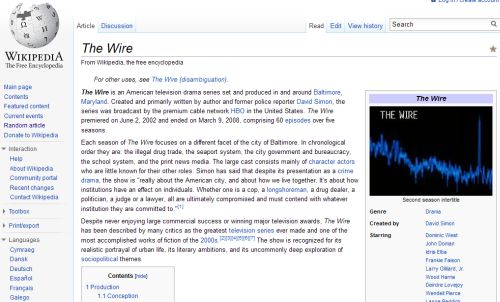Note: This guide has been updated as of 2014-09-22 for MediaWiki v1.23. If you’re using this version (or later) please see the Infoboxes in MediaWiki v1.23 post.
** Click here for the updated post. **
If you’ve ever been to any of the more structured Wikipedia pages you probably have seen the neat “infoboxes” that they have on the right hand side. They’re a neat, convenient way to get some of the core metainfo from an article.
If you have your own MediaWiki instance, you’ve probably thought they’d be a nice thing to have, so maybe you copy and pasted the code from Wikipedia and then were surprised when it didn’t just magically work. Turns out that the infobox stuff is part of MediaWiki’s extensive Templating system, so first of all you need the templates. Sounds easy, right?
Well, no. You don’t just flip a switch or download a file, and when you do a search you might find this article which details a process that it says might take 60-90 minutes.
I started looking into it and quickly got lost; you basically need to create a billion different Templates and do all sorts of weird stuff to get it to work. Fortunately I stumbled across this discussion which contained a clue that greatly simplifies the process.
I was able to distill the steps down to a process that I was able to reproduce on a new MediaWiki install in about five minutes. Before we start, I’ll throw in the warning that I have not read the documentation and I don’t understand at a low level what is happening with the templating. I just wanted a working, simple infobox.
- Download the MediaWiki extension ParserFunctions and add it to your LocalSettings.php as referred to there.
- Copy the CSS required to support the infobox from Wikipedia to your Wiki. The CSS is available in Common.css. You’ll probably need to create the stylesheet – it will be at http://your_wiki/wiki/index.php?title=MediaWiki:Common.css&action=edit – and then you can just copy/paste the contents in there. (I copied the whole file; you can probably just copy the infobox parts.)
- Export the infobox Template from Wikipedia:
- Go to Wikipedia’s Special:Export page
- Leave the field for ‘Add pages from category’ empty
- In the big text area field, just put in “Template:Infobox”.
- Make sure the three options – “Include only the current revision, not the full history”, “Include templates”, and “Save as file” – are all checked
- Hit the ‘Export’ button; it will think for a second then spit out an XML file containing all the Wikipedia Templates for the infobox for you to save to your PC.
- Now you have the Template, you need to integrate them into your MediaWiki instance. Simply go to your Import page – http://your_wiki/wiki/index.php/Special:Import – select the file and then hit ‘Upload file’. NOTE: see update at the bottom of the page before doing this.
- With the Templates and styles added you should be able to now add a simple infobox. Pick a page and add something like this to the top:
{{Infobox
|title = Infobox Title
|header1 = Infobox Header
|label2 = Created by
|data2 = David
|label3 = External reference
|data3 = [https://trog.qgl.org trog.qgl.org]
}}
The full infobox Template docs are available here – there’s a lot of stuff in there, but if you just want a really basic infobox then this is the simplest way I found to get them working.
I tested this on two separate MediaWiki installs – one running v1.12.1 and one on v1.15.1 – and it worked on both of them, but as always YMMV.
Update 2013-07-27
As many people have noticed, the guide no longer works. Thanks to commenters jh and chojin, it looks like you also need to do the following:
- Install the Scribunto extension and add it to your LocalSettings.php as usual. It looks like this extension is now required for the InfoBox templates (in fact, it looks like it replaces ParserFunctions entirely, but I’m still testing that).
- The XML file that is output in step 3 appears to erroneously (?) use text/plain as the format type. If you edit this XML file in your text editor and replace all incidents of ‘text/plain’ with ‘CONTENT_FORMAT_TEXT’ (I only found two), the import will be successful and the infobox tags looks like they work.
If someone else can confirm this for me as a working solution I’ll revise the original post so it takes these steps into account.
